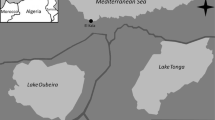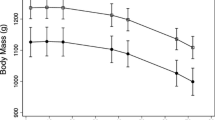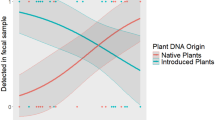Abstract
Atlantic Canada is the northern limit of the American black duck (Anas rubripes) wintering range, and more recently, the mallard (A. platyrhynchos) wintering range. Atlantic Canada has experienced considerable urban and agricultural development over the last century, and wintering black ducks and mallards appear to be using these habitats, in addition to traditional coastal habitat to survive the winters. This paper combines digestive tract content and stable isotope analysis to provide a comprehensive analysis of winter black duck and mallard diet in Atlantic Canada, and compares mallard and black duck winter diet in agricultural and coastal areas. Coastal black ducks wintering in Atlantic Canada had a diet consisting mainly of marine invertebrates and wild plant matter, while coastal mallards appeared to rely less on invertebrates and more on plant matter through winter. As winter progressed, the agricultural black ducks relied more on the feed provided by the farmer at our study site, indicated by a significant decline in their δ15N ratios. Mallards at the agricultural site maintained a low and steady δ15N ratio through winter, indicating a less diverse winter diet than sympatrically-wintering black ducks. Urban black ducks had a diet consisting entirely of vegetation and anthropogenic food supplies, which appeared to meet their nutritional requirements for winter survival. Our research highlights the importance of agricultural and urban habitats for wintering black ducks and mallards in Atlantic Canada.



Similar content being viewed by others
References
Albright J, Owen RB, Corr PO (1983) The effects of winter weather on the behaviour and energy reserves of black ducks in Maine. Transactions of the Northeast Section of the Wildlife Society 40:118–128
Ankney CD, Dennis DG, Bailey RC (1987) Increasing mallards, decreasing American black ducks: coincidence or cause and effect? J Wildl Manag 51:523–529
Ashley, P. K., Hobson, K. A., Van Wilgenburg, S. L., North, N., Petrie, S. A., 2010. Linking Canadian harvest juvenile American black ducks to their hatal areas using stable isotope (δD, δ13C, and δ15N) methods. Avian Conservation and Ecology 5(2). http://www.ace-eco.org/vol5/iss2/art7/. doi: 10.5751/ACE-00397-050207
Atkeson TZ, Lawrence SG (1952) Upland farming as a method of supplementing the natural waterfowl food supply in the southeast. J Wildl Manag 16(4):442–446
Baldassarre GA, Bolen EG (1984) Field-feeding ecology of waterfowl wintering on the southern High Plains of Texas. J Wildl Manag 48:63–71
Barrett RT, Camphuysen K(CJ), Anker-Nilssen T, Chardine JW, Furness RW, Garthe S, Hüppop O, Leopold MF, Montevecchi WA, Veit RR (2007) Diet studies of seabirds: a review and recommendations. ICES J Mar Sci 64(9):1675–1691. doi:10.1093/icesjms/fsm152
Bird JA, Pettygrove GS, Eadie JM (2000) The impact of waterfowl foraging on the decomposition of rice straw: mutual benefits for rice growers and waterfowl. J Appl Ecol 37:728–741
Black Duck Joint Venture Management Board (2008) Black duck Joint Venture strategic plan 2008—2013. Canadian Wildlife Service, Ottawa
Bub H (1996) Bird trapping and bird banding: a handbook for trapping methods all over the world. Cornell University Press, Ithaca New York
Canadian Rural Revitalization Foundation (2015) State of Rural Canada Report http://sorc.crrf.ca/
Conroy MJ, Miller MW, Hines JE (2002) Identification and synthetic modeling of factors affecting American black duck populations. Wildl Monogr 150:1–64
Core Team R (2015) R: a language and environment for statistical computing. R Foundation for Statistical Computing, Vienna https://www.R-project.org/
Dahl TE (2011) Status and trends of wetlands in the conterminous United States 2004 to 2009. US Department of the Interior. US Fish and Wildlife Service, Fisheries and Habitat Conservation
Donaldson MR, Henein KM, Runtz MW (2007) Assessing the effect of developed habitat on waterbird behaviour in an urban riparian system in Ottawa, Canada. Urban Econ 10(2):139–151. doi:10.1007/s11252-006-0015-2
Drilling N, Titman RD, McKinney F (2002) Mallard (Anas platyrhynchos). In: Rodewald PG (ed) The birds of North America. Cornell Lab of Ornithology, Ithaca Retrieved from the Birds of North America. https://birdsna.org/SpeciesAccount/bna/species/mallard
English MD, Robertson GJ, Mallory ML (2015) Trace element and stable isotope analysis of fourteen species of marine invertebrates from the bay of Fundy, Canada. Mar Pollut Bull 101(1):466–472. doi:10.1016/j.marpolbul.2015.09.046
Federal, Provincial and Territorial Governments of Canada (2010) Canadian biodiversity: ecosystem status and trends 2010. Canadian Councils of Resource Ministers, Ottawa, p 142
Figley WK, VanDruff LW (1982) The ecology of urban mallards. Wildl Monogr 81:3–39
Fry B (1988) Food web structure on Georges Bank from stable C, N, and S isotopic compositions. Limnol Oceanogr 33(5):1182–1190
Greer DM (1982) Urban waterfowl population: ecological evaluation of management and planning. Environ Manag 6(3):217–229. doi:10.1007/BF01866885
Haramis GM, Nichols JD, Pollock KH, Hines JE (1986) The relationship between body mass and survival of wintering canvasbacks. Auk 103(3):506–514
Harris HJ Jr, Ladowski JA, Worden DJ (1981) Water-quality problems and management of an urban waterfowl sanctuary. J Wildl Manag 45(2):501–507. doi:10.2307/3807934
Hobson KA, Ambrose W, Renaud P (1995) Sources of primary production, benthic-pelagic coupling, and trophic relationships within the Northeast water Polynya: insights from δ13C and δ15N analysis. Mar Ecol Prog Ser 128:1–10. doi:10.3354/meps128001
Jones OE, Williams CK, Castelli PM (2014) A 24-hour time-energy budget for wintering American black ducks (Anas rubripes) and its comparison to allometric estimations. Waterbirds 37(3):264–273. doi:10.1675/063.037.0305
Jorde DG, Owen RB (1988) Efficiency of nutrient use by American black ducks wintering in Maine. J Wildl Manag 52(2):209–214. doi:10.2307/3801224
Jorde DG, Owen RB (1990) Foods of black ducks Anas rubripes wintering in marine habitats of Maine USA. Can Field Nat 104(2):300–302
Kross J, Kaminski RM, Reinecke KJ, Penny EJ, Pearse AT (2008) Moist-soil seed abundance in managed wetlands in the Mississippi Alluvial Valley. J Wildl Manag 72:707–714
Lieske DJ, Pollard B, Gloutney M, Milton R, Connor K, Dribblee R, Parsons G, Howerter D (2012) The importance of agricultural landscapes as key nesting habitats for the American black duck in maritime Canada. Waterbirds 35(4):525–534
Longcore JR, McAuley DG, Hepp GR, Rhymer JM (2000) AAmerican Black Duck (Anas rubripes), In: Rodewald PG (ed) The birds of North America. Cornell lab of ornithology, Ithaca Retrieved from the Birds of North America: https://birdsna.org/Species-Account/bna/species/ambduc
Maisonneuve C, Bélanger L, Bordage D, Jobin B, Grenier M, Beaulieu J, Gabor S, Filion B (2006) American black duck and mallard breeding distribution and habitat relationships along a forest-agriculture gradient in southern Québec. J Wildl Manag 70(2):450–459
McCorquodale DB, Knapton RW (2003) Changes in numbers of wintering American black ducks and mallards in urban Cape Breton Island, Nova Scotia. Northeast Nat 10(3):297–304. doi:10.2307/3858699
McKinney RA, McWilliams SR, Charpentier MA (2006) Waterfowl–habitat associations during winter in an urban North Atlantic estuary. Biol Conserv 132(2):239–249. doi:10.1016/j.biocon.2006.04.002
Merendino MT, Ankney CD, Dennis DG (1993) Increasing mallards, decreasing American black ducks: more evidence for cause and effect. J Wildl Manag 57(2):199–208. doi:10.2307/3809414
Miller GA, Chapman JP (2001) Misunderstanding analysis of covariance. J Abnorm Psychol 110(1):40–48
Morton ES (1998) Pairing in mallards and American black ducks: a new view on population decline in American black ducks. Anim Conserv 1(4):239–244
Morton JM, Fowler AC, Kirkpatrick RL (1989) Time and energy budgets of American black ducks in winter. J Wildl Manag 53(2):401–410. doi:10.2307/3801143
Morton JM, Kirkpatrick RL, Vaughan MR (1990) Changes in body composition of American black ducks wintering at Chincoteague, Virginia. Condor 92(3):598–605. doi:10.2307/1368679
Reinecke KJ, Stone TL, Owen RB (1982) Seasonal carcass composition and energy balance of female black ducks in Maine. Condor 84(4):420–426. doi:10.2307/1367447
Seymour NR (1992) Interspecific territoriality and competitive interactions between American black ducks Anas rubripes and mallard A. platyrhynchos. Wild 43(43):152–155
Seymour NR, Mitchell SC (2006) American black duck Anas rubripes and mallard A. platyrhynchos abundance, occurrence of heterospecific pairing and wetland use between 1976 and 2003 in northeastern Nova Scotia, Canada. Wild 56:79
Statistics Canada (2012) 2011 Census of agriculture Retrieved from http://www.statcan.gc.ca/pub/95-640-x/95-640-x2011001-eng.htm
Statistics Canada (2016) Labour force survey estimates (LFS), employment by North American Industry Classification System (NAICS), seasonally adjusted and unadjusted, monthly (persons) Retrieved from http://www5.statcan.gc.ca/cansim/a26
USFWS (2016) Waterfowl population status, 2016. U.S. Department of the Interior, Washington DC
USFWS, CWS (1986) North American waterfowl management plan. Washington DC
Vander Zanden MJ, Clayton MK, Moody EK, Solomon CT, Weidel BC (2015) Stable isotope turnover and half-life in animal tissues: a literature synthesis. PLoS One 10(1):e0116182. doi:10.1371/journal.pone.0116182
Welsh PO, Paszkowski CA, Tierney KB (2016) Mallards (Anas platyrhynchos) and wastewater ponds, Part I: Mallard ducks overwintering at a northern wastewater treatment pond. Ecotoxicol Environ Saf. doi:10.1016/j.ecoenv.2016.10.038
Williams CK, Dugger BD, Brasher MG, Coluccy JM, Cramer DM, Eadie JM, Gray MJ, Hagy HM, Livolsi M, McWilliams SR, Petrie M, Soulliere G, Tirpak J, Webb E (2014) Estimating habitat carrying capacity for migrating and wintering waterfowl: considerations, pitfalls and improvements. Wild 4:407–435
Acknowledgements
This study would not have been possible without cooperation from landowners and hunters in Atlantic Canada. Specifically, we thank Randy Milton, Danny Sears, Lee Millet, and Gary Thurber for collecting the ducks used for full carcass analysis, and Wayne and Mike Oulton for allowing us to band ducks on their farm in Martock. Employees from Department of Natural Resources (Nova Scotia) and Canadian Wildlife Service (Atlantic Region) were essential in aiding with banding efforts throughout Atlantic Canada. Funding for this research came from the Black Duck Joint Venture, Environment Canada operating funds, and Acadia University. We thank the anonymous referees for providing comments that improved our manuscript.
Author information
Authors and Affiliations
Corresponding author
Rights and permissions
About this article
Cite this article
English, M.D., Robertson, G.J., Peck, L.E. et al. Agricultural food resources and the foraging ecologies of American black ducks (Anas rubripes) and mallards (Anas platyrhynchos) at the northern limits of their winter ranges. Urban Ecosyst 20, 1311–1318 (2017). https://doi.org/10.1007/s11252-017-0683-0
Published:
Issue Date:
DOI: https://doi.org/10.1007/s11252-017-0683-0




